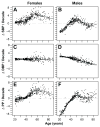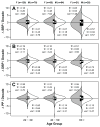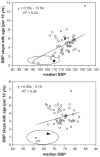Does blood pressure inevitably rise with age?: longitudinal evidence among forager-horticulturalists
- PMID: 22700319
- PMCID: PMC3392307
- DOI: 10.1161/HYPERTENSIONAHA.111.189100
Does blood pressure inevitably rise with age?: longitudinal evidence among forager-horticulturalists
Abstract
The rise in blood pressure with age is a major risk factor for cardiovascular and renal disease, stroke, and type 2 diabetes mellitus. Age-related increases in blood pressure have been observed in almost every population, except among hunter-gatherers, farmers, and pastoralists. Here we tested for age-related increases in blood pressure among Tsimane forager-farmers. We also test whether lifestyle changes associated with modernization lead to higher blood pressure and a greater rate of age-related increase in blood pressure. We measured blood pressure longitudinally on 2248 adults age ≥ 20 years (n=6468 observations over 8 years). Prevalence of hypertension was 3.9% for women and 5.2% for men, although diagnosis of persistent hypertension based on multiple observations reduced prevalence to 2.9% for both sexes. Mixed-effects models revealed systolic, diastolic, and pulse blood pressure increases of 2.86 (P<0.001), 0.95 (P<0.001), and 1.95 mmHg (P<0.001) per decade for women and 0.91 (P<0.001), 0.93 (P<0.001), and -0.02 mmHg (P=0.93) for men, substantially lower than rates found elsewhere. Lifestyle factors, such as smoking and Spanish fluency, had minimal effect on mean blood pressure and no effect on age-related increases in blood pressure. Greater town proximity was associated with a lower age-related increase in pulse pressure. Effects of modernization were, therefore, deemed minimal among Tsimane, in light of their lean physique, active lifestyle, and protective diet.
Conflict of interest statement
The authors declare no conflict of interest.
Figures





Comment in
-
"From apennines to andes:" does body mass index affect the relationship between age and blood pressure?Hypertension. 2012 Jul;60(1):6-7. doi: 10.1161/HYPERTENSIONAHA.112.192534. Epub 2012 May 21. Hypertension. 2012. PMID: 22615117 No abstract available.
References
-
- Finch C. The Biology of Human Longevity. San Diego, CA: Academic Press; 2007.
-
- O’Rourke MF, Nichols WW. Aortic diameter, aortic stiffness, and wave reflection increase with age and isolated systolic hypertension. Hypertension. 2005;45:652–658. - PubMed
-
- Baksi AJ, Treibel TA, Davies JE, Hadjiloizou N, Foale RA, Parker KH, Francis DP, Mayet J, Hughes AD. A meta-analysis of the mechanism of blood pressure change with aging. Journal of the American College of Cardiology. 2009;54:2087. - PubMed
-
- Wolf-Maier K, Cooper RS, Banegas JR, Giampaoli S, Hense H-W, Joffres M, Kastarinen M, Poulter N, Primatesta P, Rodriguez-Artalejo F, Stegmayr B, Thamm M, Tuomilehto J, Vanuzzo D, Vescio F. Hypertension Prevalence and Blood Pressure Levels in 6 European Countries, Canada, and the United States. JAMA. 2003;289:2363–2369. - PubMed
-
- Whelton PK. Epidemiology of hypertension. Lancet. 1994;344:101. - PubMed

